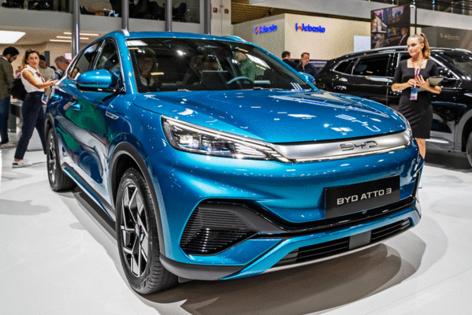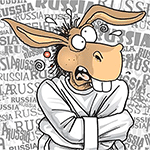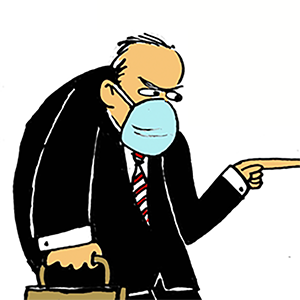Here's what reciprocal recognition of US, EU vehicle regulations could mean
Published in Automotive News
If the United States and European Union agree to recognize each other's vehicle regulations, it could increase access to low-cost vehicles, reduce automaker expenses and potentially ease obstacles for Chinese brands looking to enter the U.S. market, experts said.
A joint statement recently issued by the White House and the EU outlined a framework for a trade agreement aimed at reducing tariff and non-import tax barriers. That included mention of accepting each other's regulations and collaborating on requirements.
"With respect to automobiles, the United States and the European Union intend to accept and provide mutual recognition to each other’s standards," the statement said. "Cooperation on standards plays a crucial role in enhancing the transatlantic marketplace."
Automakers today must homologate vehicles to meet differing rules between the regions around lighting, advanced driver-assistance systems, bumpers and other specifications. The process can add millions of dollars in development costs and limit production scale opportunities. Eliminating or reducing these differences could support lower vehicle prices and higher profits, but some raise concerns about safety and whether it could result in more products from Chinese brands entering the U.S. market, creating national security concerns.
Details on how the situation could play out aren't clear, and the statement expresses an intention — not a commitment — that recognizing each other's regulations will happen, experts said. It could result in automakers selling vehicles on both sides of the Atlantic without meeting each jurisdiction's safety and emissions standards.
Others think the companies would still have to make changes to satisfy each market, but that regulators could accept each other's test results on safety, emissions and fuel economy. The United States recognizes a self-certification, while local governments in Europe establish their own processes.
"It simplifies their process for carrying over a vehicle platform," said Mitch Zajac, a trade attorney at law firm Butzel, about the impact on automakers. "It has an interesting effect on suppliers in the business of selling those components to support European standards. It doesn’t quite help them."
Matt Blunt, president of the American Automotive Policy Council, a lobby group representing the Detroit Three, said in an email: "For this standards acceptance to (be) meaningful the EU must fully accept US (Federal Motor Vehicle Safety Standards) and environmental testing and certifications."
The typical monthly payment for a new vehicle in July was $748, down 1.7% year-over-year, according to automotive services provider Cox Automotive Inc. But costs of new tariffs continue to work their way through the supply chain, and an up-to-$7,500 federal tax credit for plug-in vehicles expires at the end of September.
If there were fewer barriers to selling European vehicles in the United States, there could be greater opportunity to import smaller, lower-cost options. Consumer willingness to purchase those vehicles, however, could be questionable. Americans tend to prefer larger SUVs and trucks that often bloat the narrower roads and parking spaces in Europe. The 27-nation bloc's more aggressive emissions regulations have also contributed to more plug-in hybrid and all-electric options.
Nonetheless, acceptance of regulations and greater harmonization in standards could create opportunities for scale on platforms and reduce costs, said K. Venkatesh Prasad, senior vice president of research and chief innovation officer at the Center for Automotive Research in Ann Arbor.
"This would help with that," he said. "You would differentiate in the top hat. It could open the way for easier, smoother joint ventures."
Still, the framework statement has particularly raised concerns from safety advocates and environmental groups in Europe.
"By signing up to mutual recognition of vehicle standards with the United States, the European Union has waved the white flag on road safety," Antonio Avenoso, executive director of the European Transport Safety Council, said in a statement. "This is not a technical detail — it is a political choice that puts trade convenience ahead of saving lives."
The U.S. National Highway Traffic Safety Administration estimates there were 39,345 traffic fatalities in 2024. The European Commission's preliminary figures put road fatalities at around 19,800 deaths for last year.
Still, mutual recognition could negate the need for European automakers to install larger bumpers, tougher rear-end-collision protection hardware and certain required electronic safety features.
"I don’t buy into that U.S. cars aren’t safe," Zajac said. "In the U.S., we have tougher standards around crash worthiness."
Canada's push
The United States isn't alone in looking at regulatory collaboration with Europe. Since the spring, Canadian auto dealers have urged their country to adopt vehicle regulations from allies like Europe, Japan and South Korea in an effort to reduce reliance on pricey U.S. imports in response to tariffs imposed by President Donald Trump's administration. The Canada Motor Vehicle Safety Standards have largely aligned with the U.S. standards for decades.
Tim Reuss, CEO of the Canadian Automobile Dealers Association, said the trade group was happy to see the issue mentioned in the U.S.-EU framework and that it supported its work on the topic with Canadian trade officials.
CADA's proposal came as the average transaction price last year of light-duty vehicles in Canada was close to $39,000 (53,745 Canadian dollars), up 31% since 2019, according to DesRosiers Automotive Consultants Inc. and Statistics Canada. Although Canadian vehicle tastes are similar to Americans', urban areas especially can tend toward European preferences, making some smaller vehicles like hatchbacks more popular.
"There's a lot of vehicles we don't get because they wouldn't find traction in the U.S.," said Niel Hiscox, CEO of Clarify Group Inc., an Ontario-based automotive research and consulting firm that contributed to CADA's proposal. "If we were to not just continue to recognize the existing Canadian and U.S. standards, but to recognize European standards, suddenly that would make a whole range of vehicles available."
Steve Chipman, CEO of Birchwood Automotive Group with 21 dealerships in Manitoba, Saskatchewan and North Dakota, said he's not sure how popular vehicles developed for regions like Europe would be, but "Mr. Trump and his tariffs have united people. To me, the strongest pitch is: 'Hey, we need cars, and people need electric vehicles, and to not be dependent on the U.S.'"
Transport Canada, the government ministry overseeing transportation policies, is aware of recent calls to allow for the importation of international regulatory counterparts, spokesperson Hicham Ayoun said in an email.
"The certification requirements of other jurisdictions may not be sufficient to meet the safety needs of Canadian road users due to Canada’s distinct driving environment," he said. "This includes Canada’s large geography and wide population distribution, which has resulted in stringent crash test standards better suited for Canada’s road infrastructure, speed limits and the larger vehicle sizes found on Canadian roadways today. For example, some European crash testing requirements are not as stringent as the Canadian regime due to differences in their driving environment."
At that, Reuss chuckles: "Are you going to tell me that a vehicle that's been safe enough and environmentally OK to be driven at over 200 kilometers an hour (124 mph) on a German Autobahn is not safe enough to be driven in Canada? Really?"
Opportunity for China?
One pushback in allowing vehicles certified under European rules is whether it would increase the number of vehicles from Chinese brands in North America, raising national security concerns and potentially threatening legacy automakers' manufacturing here.
"This could help to reduce the friction for something like that," Prasad said about the United States and EU recognizing each other's regulations.
It's not an unprecedented concern. For years, Mexico has accepted imports of vehicles certified under the United Nations Economic Commission for Europe's regulations, which are used by many nations globally. That's facilitated entrance into the market by Chinese brands that are also expanding into Europe and other regions. Now, they represent roughly 20% of new vehicle sales in Mexico, mostly from imports certified under UNECE.
Those imports mainly come from China. It's unlikely a trade deal with the EU would create a "three-party daisy chain opportunity" for Chinese brands to export to the United States from China, Zajac said, but Chinese automakers are expanding production in Europe. Global EV leader BYD Co., Ltd. has a plant in Hungary, and Chery Auto has a joint venture with Spain's EV Motor for assembly in Western Europe.
If Chinese automakers simply import parts from China to be assembled in another country, the product likely still would face tariffs arriving in the United States, trade experts have said. If there were efforts to circumvent that, it could be addressed later, a White House official told The Detroit News.
Benefited by Chinese government subsidies, Chinese automakers have been characterized as an "existential threat" by the likes of Ford CEO Jim Farley because of their low manufacturing costs and inexpensive EVs. Experts say the Chinese are years ahead of domestic manufacturers.
But the U.S. market is competitive, and leaders haven't made it easy for Chinese brands to enter. Trump has increased tariffs on China, and his predecessor, Joe Biden, imposed a 100% duty on Chinese EVs. The Biden administration also finalized a rule that bans the import and sale of passenger vehicles with internet-connected technology from China over national security concerns.
BYD was looking at Mexico for an export hub to Latin America, but since Trump instituted the 25% tariff on Mexico, any plans for BYD there appear stalled. In Canada, CADA's Reuss told The News that the group's push to adopt ally-nation rules "is not the proposal to open up the Canadian market to Chinese vehicles."
The proposal notes that adopting foreign regulations in addition to the existing regulatory framework could create interest by automakers that don't already have retail and service support for consumers. If Canada were to act, it suggests doing so for "only recognized OEMs with established operations in Canada," according to its written proposal.
"It's not our position that we're against the Chinese, to be clear; we're saying this proposal is to expand our business in certain areas," Reuss said. "There's an affordability crisis that we're currently having in Canada that is getting worse and will continue to worsen. And this would be one way of alleviating some of that now by bringing in vehicles in smaller segments, or different segments that customers want, at a different price point that they currently cannot get."
The CADA report identifies 64 models from brands already selling in Canada that are sold in Mexico, but not in Canada. They're mostly smaller cars, compact and subcompact SUVs, and commercial vehicles.
Trump has indicated a willingness for Chinese automakers to invest in the United States, though leaders in some automotive states have said they wouldn't entertain such proposals. A new trade agreement in North America could facilitate greater access for Chinese brands to the U.S. market.
"Keeping those manufacturers out of the U.S. market also delays their investment in local plants," said Sam Fiorani, vice president of global vehicle forecasting at AutoForecast Solutions LLC. "You have to introduce the product before they introduce the plant. Canadians and Americans want affordable vehicles, and the Chinese are providing those. It's only a matter of time before the market asks for it, and it's fulfilled."
©2025 www.detroitnews.com. Visit at detroitnews.com. Distributed by Tribune Content Agency, LLC.








Comments